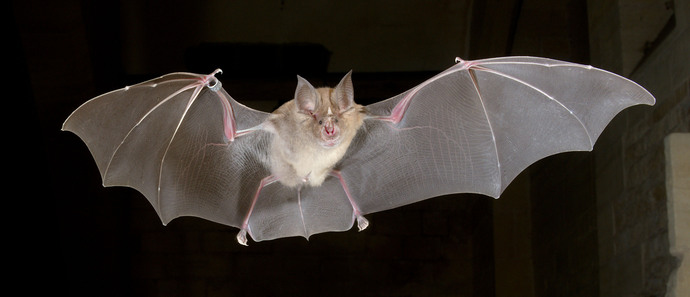First ever bat stem cells could reveal how coronaviruses spread and evade the immune system in new hosts
Posted 22 February, 2023

The Greater Horseshoe Bat (Rhinolophus ferrumequinum) Credit: Daniel Whitby, © and permission
For the first time an international team of scientists have generated induced pluripotent stem cells (iPSCs) from bats, giving fresh insight into their remarkable defences against ageing, viruses, and cancer.
(opens in a new window)The new study, published in Cell, opens the door to studying how viruses like SARS-CoV-2, which causes COVID-19, survive, spread, and evade the immune system through molecular adaptations to new hosts.
Researchers from (opens in a new window)University College Dublin and the Icahn School of Medicine at Mount Sinai, USA, created the iPSCS from the wild greater horseshoe bat (Rhinolophus ferrumequinum), which are considered asymptomatic carriers of coronaviruses, including those related to SARS-CoV-2, and also the greater Mouse eared bat (Myotis myotis), a new model for extreme longevity.
“This study represents a game-change in bat biology,” says senior author (opens in a new window)Professor Emma Teeling, Professor of Zoology at UCD School of Biology and Environmental Science.
“Until now we have been limited in our understanding of how bats limit ageing and disease. We can now take a 3mm biopsy wing punch from any bat species, release the animal unharmed, and use this to grow any bat cell type we need. We can do the molecular biology experiments required to really understand the biological basis of bats’ extraordinary abilities.”
Senior author Professor Thomas Zwaka, Professor of Cell, Developmental and Regenerative Biology at Icahn Mount Sinai, added: “Our study suggests that bats have evolved mechanisms to tolerate a large load of viral sequences, and they may have a more entwined relationship with viruses than previously thought.
“This takes on new relevance given the fact that many species of bats have been shown to tolerate and survive viruses that have high mortality rates in humans, including SARS-CoV, SARS-CoV-2, MERS-CoV, and Marburg. The reason could be a modulation of bats’ innate immune response, which renders them asymptomatic and tolerant virus hosts.”
Induced pluripotent stem cells (iPSCs) are created by genetically and chemically reprogramming skin or blood cells into newborn stem cells, which have the potential to become any cell in the body.
They have the unique ability to divide indefinitely in culture and turn into immune cells and tissues (like lung or gut epithelium), making them amenable to gene editing and molecular studies, according to first author of the study, Associate Professor Marion Dejosez, Icahn Mount Sinai.
The researchers believes they could help answer such important questions as how bats tolerate viral infections and whether they genetically simulate tactics employed by viruses to evade the immune system, thus promoting fertile ground for virus production.
“Future research on bat stem cells will directly impact every aspect of our understanding of bat biology, including bats’ amazing adaptations of flight and ability to locate distant or invisible objects through echolocation, the location of objects reflected by sound, as well as their extreme longevity and unusual immunity,” said Dr Zwaka.
Until now, no reliable cellular models existed for studying bat biology or their responses to viral infections, thus hindering a deeper understanding of their genomic adaptations.
“Comparing bat iPSCs to other mammals enabled us to uncover a unique stem cell biology never observed before,” said senior author Dr Adolfo García-Sastre and Dr Arthur M. Fishberg, Icahn Mount Sinai.
“The most extraordinary finding was the presence of large virus-filled vesicles in bat stem cells representing major viral families, including coronaviruses, without compromising the cells’ ability to proliferate and grow. This could suggest a new paradigm for virus tolerance as well as a symbiotic relationship between bats and viruses.”
Some of greatest scientific gains are expected to be in the bat virosphere and in novel anti-ageing mechanisms.
“This study provides the tools required to validate the novel anti-ageing solutions and innovations evolved in bats, allowing us to develop new therapeutics to limit the maladies of ageing and improve disease resistance,” said Professor Teeling, whose lab studies wild bats to uncover how they age so slowly.
“Our study establishes a platform to further understand the unique role bats play among mammals as virus reservoirs,” said Dr García-Sastre.
“And that knowledge could provide the field with broad new insights into disease and therapeutics while preparing us for future pandemics.”
This study was funded by Science Foundation Ireland, the Irish Research Council, the National Institutes of Health, the National Institute of General Medical Sciences, the Eunice Kennedy Shriver National Institute of Child Health and Human Development, and the Huffington Foundation.
By: David Kearns, Digital Journalist / Media Officer, UCD University Relations






